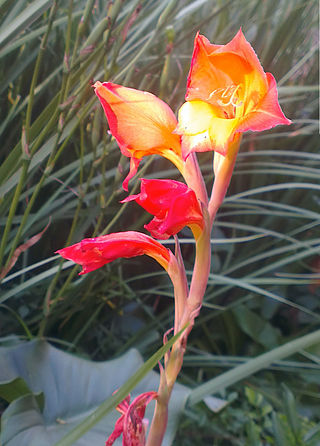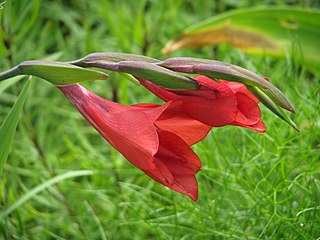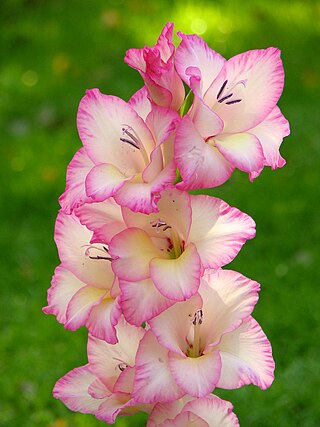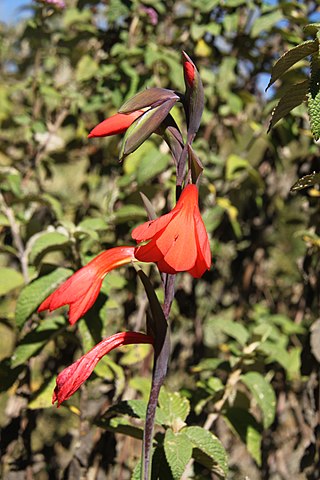
Corm, bulbo-tuber, or bulbotuber is a short, vertical, swollen underground plant stem that serves as a storage organ that some plants use to survive winter or other adverse conditions such as summer drought and heat (perennation).

Iridaceae is a family of plants in order Asparagales, taking its name from the irises. It has a nearly global distribution, with 69 accepted genera with a total of c. 2500 species. It includes a number of economically important cultivated plants, such as species of Freesia, Gladiolus, and Crocus, as well as the crop saffron.
HMS Gladiolus was a Flower-class corvette of the Royal Navy, the first ship of her class.

Gladiolus is a genus of perennial cormous flowering plants in the iris family (Iridaceae).

Gladiolus dalenii is a species of flowering plant in the iris family Iridaceae. It is one of the most widely distributed species of Gladiolus, ranging from eastern South Africa and Madagascar throughout tropical Africa and into western Arabia. It is the main parental species of the large flowering grandiflora hybrids. This species is also unusual in its genus in including diploid, tetraploid and hexaploid races. The hybrids produced from it are often tetraploids.

Gladiolus angustus is a species of gladiolus known by the common name long-tubed painted lady. It is native to the Cape Provinces of South Africa.

Gladiolus crassifolius is a species of Gladiolus found in Africa. It is a perennial species with substantial stems and brightly coloured flowers. There are many synonyms of Gladiolus crassifolius.

Gladiolus italicus is a species of gladiolus known by the common names Italian gladiolus, field gladiolus, and common sword-lily. It is native to much of Eurasia and North Africa, but it is well known on other continents where it is a common weed, particularly of cultivated fields and waste places. This perennial flower grows an erect stem approaching a meter in maximum height with a few long leaves around its base. Toward the top half of the generally unbranching stem is a spike inflorescence on which flowers appear at intervals. Each plant has up to 15 or 16 flowers. The flower is bright pink to magenta and several centimeters long with its stamens and style protruding from the throat. The fruit is a capsule about a centimeter long containing many seeds.

Gladiolus tristis is a species of gladiolus known by several common names, including ever-flowering gladiolus and marsh Afrikaner. It is native to southern Africa, especially South Africa. It is known in parts of Australia and coastal California as an introduced species. It is sometimes grown as a garden plant. This gladiolus typically grows one half to one metre in height, but has been known to approach 1.5 metres tall. It grows from a corm one or two centimetres wide. It produces three narrow, sheathing leaves. The inflorescence is a spike of two to eight large, fragrant blooms. Each flower has six white or cream tepals with greenish or purplish midlines. The flowers are said to have a scent similar to carnations and cloves. Not all individuals possess scent because the allele for its presence is recessive in relation to the allele for its absence.

Gladiolus alatus is a species of geophyte from South Africa. Common names include painted ladies, king kalkoentjie and kipkippie. Kalkoentjie means "little turkey" in Afrikaans and refers to the shape of the flower, which resembles a turkey's wattle. It is popular as a garden plant and an important part of the cut flower industry in parts of the world on account of its large and showy orange flowers.

Gladiolus flanaganii is a Gladiolus species found in cliffs of the Drakensberg in Natal, South Africa.
Gladiolus 'Robinetta' is a cultivar of Gladiolus which features fiery red blooms with dainty white markings. Its eye-catching flowers, are slightly fragrant and grow on loose spikes that are adorned by narrow, deep-green sword-shaped leaves. Blooming in early summer for 3–4 weeks, this Gladiolus grows up to 18–24 inches tall.

Gladiolus 'Priscilla' is a cultivar of Gladiolus which has tri-colored flowers. They have a white ruffled flowers with pink edges, and a soft yellow throat. The florets are arranged on strong and erect spikes adorned by pointed sword-like leaves. Blooming in mid to late summer, this Gladiolus grows up to 4–5 feet tall.
Gladiolus 'Rose Supreme' is a cultivar of Gladiolus which features warm salmon flowers with creamy hearts. These eye-catching ruffled blossoms are arranged closely and symmetrically on strong and erect spikes adorned by pointed sword-like leaves. Blooming in mid to late summer, this Gladiolus grows up to 36–48 inches tall.
Gladiolus 'Princess Margaret Rose' is a cultivar of Gladiolus which features fiery hot colors, a mix of red, orange and yellow flowers. The ruffled blossoms are arranged closely and symmetrically on strong and erect spikes adorned by pointed sword-like leaves. Blooming in mid to late summer, between June and September, it can grow up to 36–48 inches tall.
Gladiolus 'White Prosperity' is a cultivar of 'Gladiolus', it has large, pure white flowers with ruffled petals, blooming from mid to late summer.
Thrips simplex is a species of insect in the genus Thrips in the order Thysanoptera. It is commonly known as the gladiolus thrips and infests gladiolus plants as well as various other monocotyledonous plants such as lilies, irises and freesias.

Gladiolus watsonioides is a medium to high (½–1 m), herbaceous geophyte with sword-shaped leaves, flattened in the plain of the stem, and spikes of red funnel-shaped flowers, that is assigned to the iris family. In the wild, the species is restricted to the highlands of central Kenya and northern Tanzania, including on Kilimanjaro, Mount Kenya and the Aberdare Range. It is sometimes called Mackinder's gladiolus.
Gladiolus mariae is a species of the genus Gladiolus of perennial cormous flowering plants in the family Iridaceae.










